lock Oldsmobile Cutlass 1998 s User Guide
[x] Cancel search | Manufacturer: OLDSMOBILE, Model Year: 1998, Model line: Cutlass, Model: Oldsmobile Cutlass 1998Pages: 348, PDF Size: 17.46 MB
Page 70 of 348
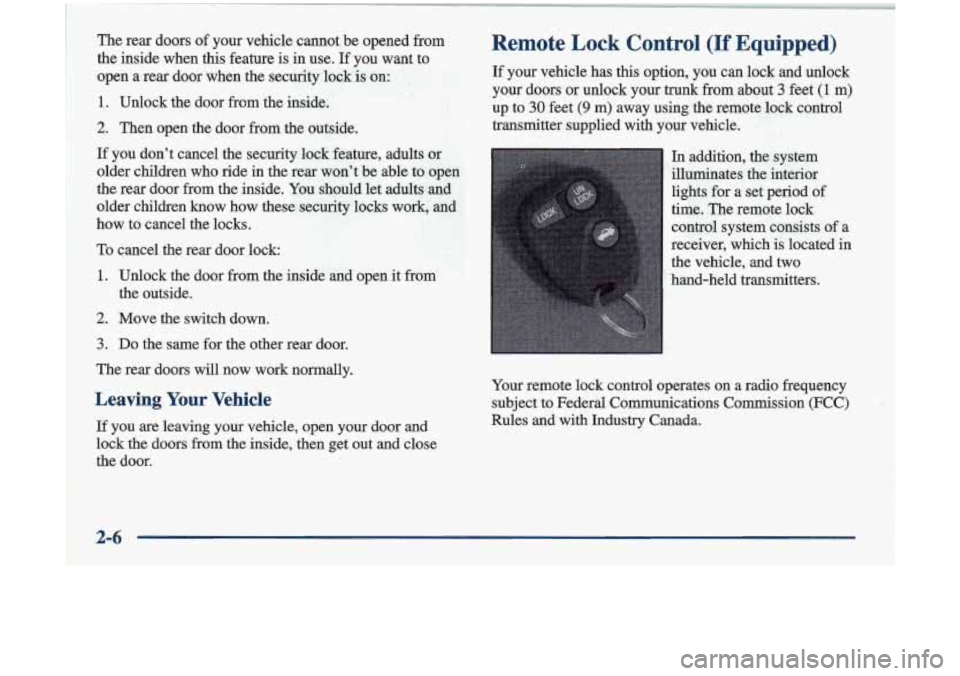
Remote Lock Control (If Equipped)
If your vehicle has this option, you can lock and unlock
your doors
or unlock your trunk from about 3 feet (1 m)
up to
30 feet (9 m) away using the remote lock control
transmitter supplied with your vehicle.
In addition, the system
illuminates the interior
lights for a set period of
time. The remote lock
control system consists
of a
receiver, which
is located in
the vehicle, and two
hand-held transmitters.
Your remote lock control operates on a radio frequency
subject
to Federal Communications Commission (FCC)
Rules and with Industry Canada.
Page 71 of 348
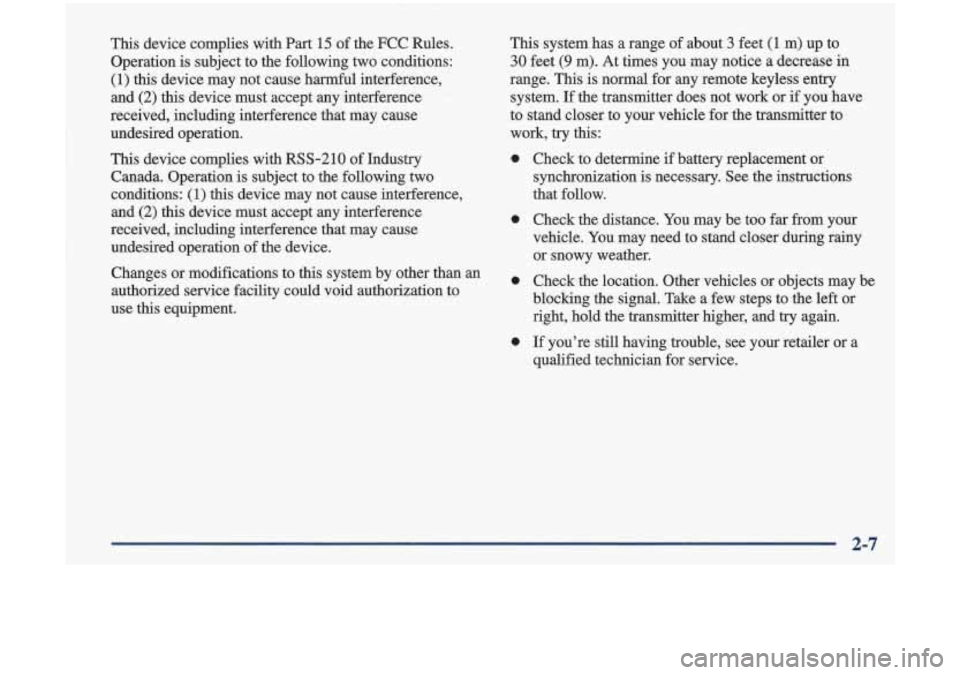
This device complies with Part 15 of the FCC Rules.
Operation is subject to the following two conditions:
(1) this device may not cause harmful interference,
and
(2) this device must accept any interference
received, including interference that may cause
undesired operation.
This device complies with RSS-210 of Industry
Canada. Operation is subject to the following
two
conditions: (1) this device may not cause interference,
and
(2) this device must accept any interference
received, including interference that may cause
undesired operation of the device.
Changes or modifications to this system by other than an
authorized service facility could void authorization to
use this equipment. This system has
a range of about
3 feet (1 m) up to
30 feet (9 m). At times youmay notice a decrease in
range. This is normal for any remote keyless entry
system. If the transmitter does not work or
if you have
to stand closer to your vehicle for the transmitter to
work, try this:
e
e
e
e
Check to determine if battery replacement or
synchronization is necessary. See the instructions
that follow.
Check the distance. You may be too
far from your
vehicle. You may need to stand closer during rainy
or snowy weather.
Check the location. Other vehicles or objects may be
blocking the signal. Take a few steps to the left or
right, hold the transmitter higher, and
try again.
If you’re still having trouble, see your retailer or a
qualified technician for service.
2-7
Page 72 of 348
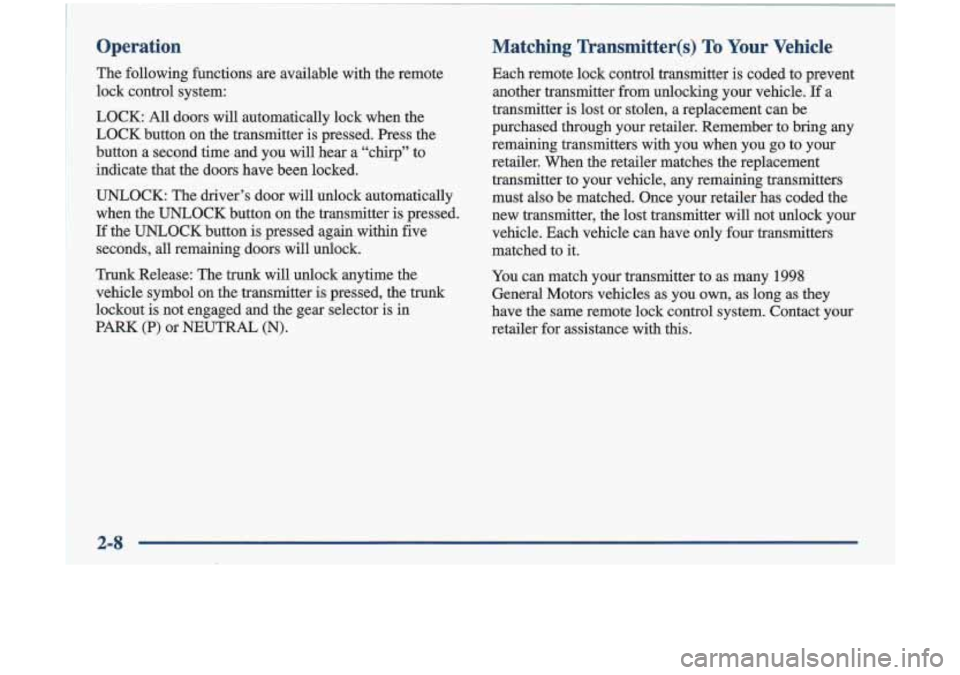
Operation
The following functions are available with the remote
lock control system:
LOCK:
All doors will automatically lock when the
LOCK button on the transmitter is pressed. Press the
button a second time and you will hear a “chirp” to
indicate that the doors have been locked.
UNLOCK: The driver’s door will unlock automatically
when the UNLOCK button on the transmitter
is pressed.
If the UNLOCK button is pressed again within five
seconds, all remaining doors will unlock.
Trunk Release: The trunk will unlock anytime the
vehicle symbol on the transmitter is pressed, the trunk
lockout is not engaged and the gear selector is in
PARK (P) or NEUTRAL (N).
Matching Transmitter(s) To Your Vehicle
Each remote lock control transmitter is coded to prevent
another transmitter
from unlocking your vehicle. If a
transmitter is lost or stolen, a replacement can be
purchased through your retailer. Remember to bring any
remaining transmitters with you when you go to your
retailer. When the retailer matches the replacement transmitter to your vehicle, any remaining transmitters
must also be matched. Once your retailer has coded the
new transmitter, the lost transmitter will not unlock your
vehicle. Each vehicle can have only four transmitters
matched to it.
You can match your transmitter to as many
1998
General Motors vehicles as you own, as long as they
have the same remote lock control system. Contact your
retailer for assistance with this.
2-8
Page 73 of 348
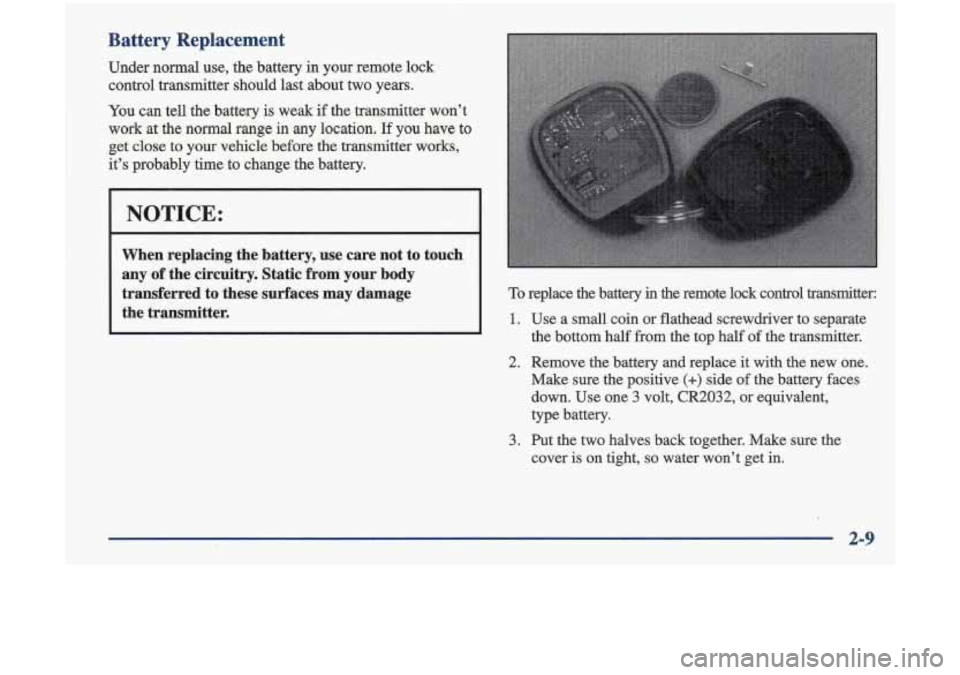
Battery Replacement
Under normal use, the battery in your remote lock
control transmitter should last about two years.
You can tell the battery
is weak if the transmitter won’t
work at the normal range in any location.
If you have to
get close to your vehicle before the transmitter works,
it’s probably time to change the battery.
I NOTICE:
I I
I
When replacing the battery, use care not to touch
any of the circuitry. Static from your body
I
I transferred to these surfaces may damage I To replace the battery in the remote lock control transmitter:
I the transmitter. I 1.
2.
3.
Use a small coin or flathead screwdriver to separate
the bottom
half from the top half of the transmitter.
Remove the battery and replace it with the new one.
Make sure the positive
(+) side of the battery faces
down. Use one
3 volt, CR2032, or equivalent,
type battery.
ht the two halves back together. Make sure the
cover is on tight,
so water won’t get in.
2-9
Page 74 of 348

____ ~~ ~ ~~ ~ ~ ~~~
~ ~~~~
4. Check the operation of the transmitter with your
vehicle. If the transmitter does not work, try
synchronizing the transmitter with the receiver.
Synchronization
Your remote lock control system is equipped with a
security system that prevents anyone from recording and
playing back your signal. The transmitter does not send
the same signal twice to the receiver. The receiver will
not respond to a signal that has been sent to it more
than once.
To synchronize your transmitter and receiver, follow
these directions:
1. Stand close to your vehicle.
2. Press and hold the LOCK and UNLOCK buttons on
the transmitter at the same time.
3. Hold the buttons for five seconds. In this time, the
doors should lock and unlock once. This confirms
the resynchronization.
If the doors do not lock and
unlock, see your retailer for service.
~~~ .~ ~~ - ..
Trunk
To unlock the trunk from the outside, insert the key and
turn the trunZC lock cylinder.
It can be dangerous to drive with the trunk lid
open because carbon monoxide
(CO) gas can
come into your vehicle. You can’t see or smell
CO.
It can cause unconsciousness and even death.
If you must drive with the trunk lid open or if
electrical wiring or other cable connections must
pass through the seal between the body and the
trunk lid:
Make sure all windows are shut.
Thrn the fan on your heating or cooling
system to its highest speed with the setting on
VENT. That will force outside air into your
vehicle. See
“Comfort Controls’’ in the Index.
instrument panel, open them all the
way.
If you have air outlets on or under the
See “Engine Exhaust” in the Index.
2-10 B
.-
Page 77 of 348
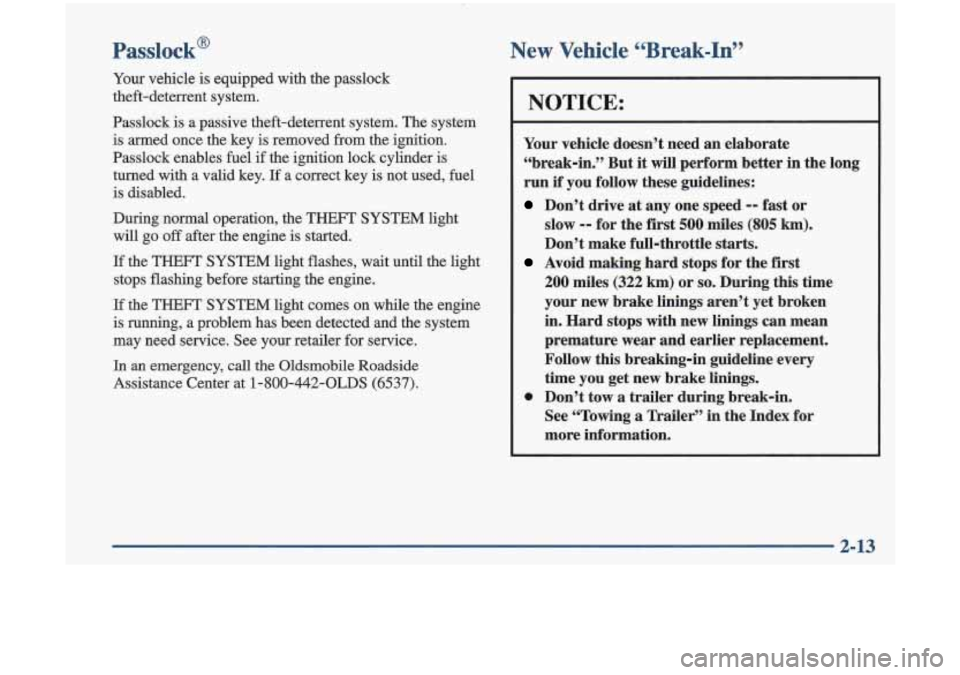
Passlock@
Your vehicle is equipped with the passlock
theft-deterrent system.
Passlock
is a~passive theft-deterrent system. The system
is armed once the key is removed from the ignition.
Passlock enables fuel if the ignition lock cylinder is
turned with a valid key.
If a correct key is not used, fuel
is disabled.
During
normal operation, the THEFT SYSm light
will go
off after the engine is started.
If the THEFT SYSTEM light flashes, wait until the light
stops flashing before starting the engine.
If the THEFT SYSTEM light comes on while the engine
is running, a problem has been detected and the system
may need service. See your retailer
for service.
In an emergency, cal
Assistance Center at 1 the Oldsmobile Roadside
1-800-442-OLDS
(6537).
New Vehicle “Break-In”
NOTICE:
Your vehicle doesn’t need an elaborate
‘70reak-in.” But
it will perform better in the long
run if you follow these guidelines:
Don’t drive at any one speed -- fast or
slow -- for the first 500 miles (805 km).
Don’t make full-throttle starts.
200 miles (322 km) or so. During this time
your new brake linings aren’t yet broken
in. Hard stops with new linings can mean
premature wear and earlier replacement.
Follow this breaking-in guideline every
time you get new brake linings.
See
“Towing a Trailer’’ in the Index for
more information.
Avoid making hard stops for the first
0 Don’t tow a trailer during break-in.
2-13
Page 78 of 348
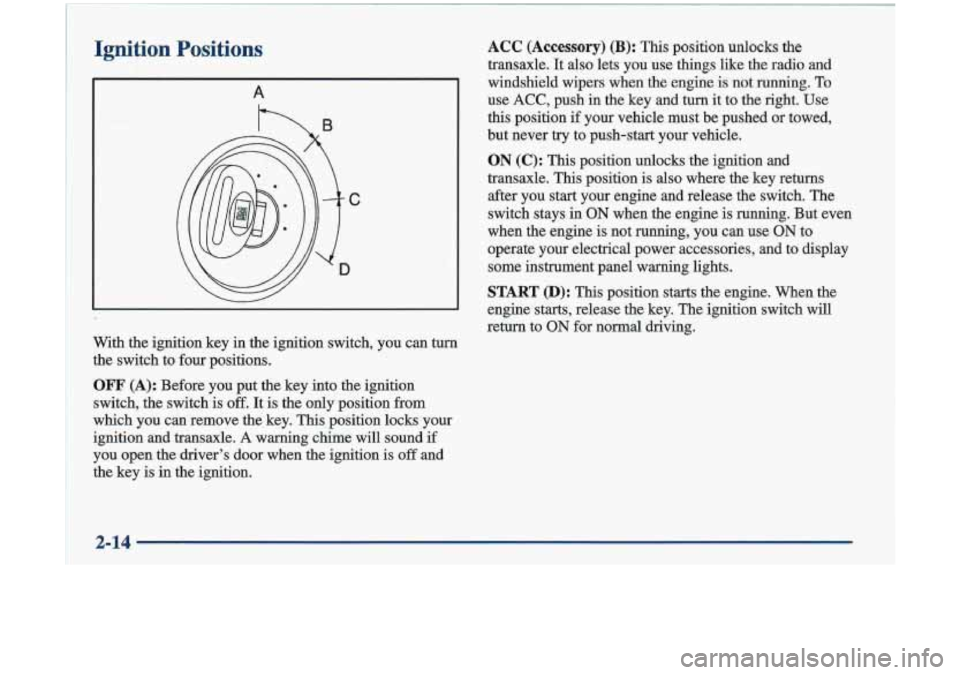
Ignition Positions
A
hB
ACC (Accessory) (B): This position unlocks the
transaxle. It also lets you use things like the radio and
windshield wipers when the engine is not running.
To
use ACC, push in the key and turn it to the right. Use
this position
if your vehicle must be pushed or towed,
but never try to push-start your vehicle.
ON (C): This position unlocks the ignition and
transaxle. This position is also where the key returns
after you
start your engine and release the switch. The
switch stays in
ON when the engine is running. But even
when the engine is not running, you can use
ON to
operate your electrical power accessories, and to display
some instrument panel warning lights.
START (D): This position starts the engine. When the
engine starts, release the key. The ignition switch will
return to
ON for normal driving.
With
the ignition key in the ignition switch, you can turn
the switch to four positions.
OFF (A): Before you put the key into the ignition
switch, the switch is
off. It is the only position from
which you can remove the key. This position locks your
ignition and transaxle.
A warning chime will sound if
you open the driver’s door when the ignition is off and
the key is in the ignition.
2-14
Page 82 of 348
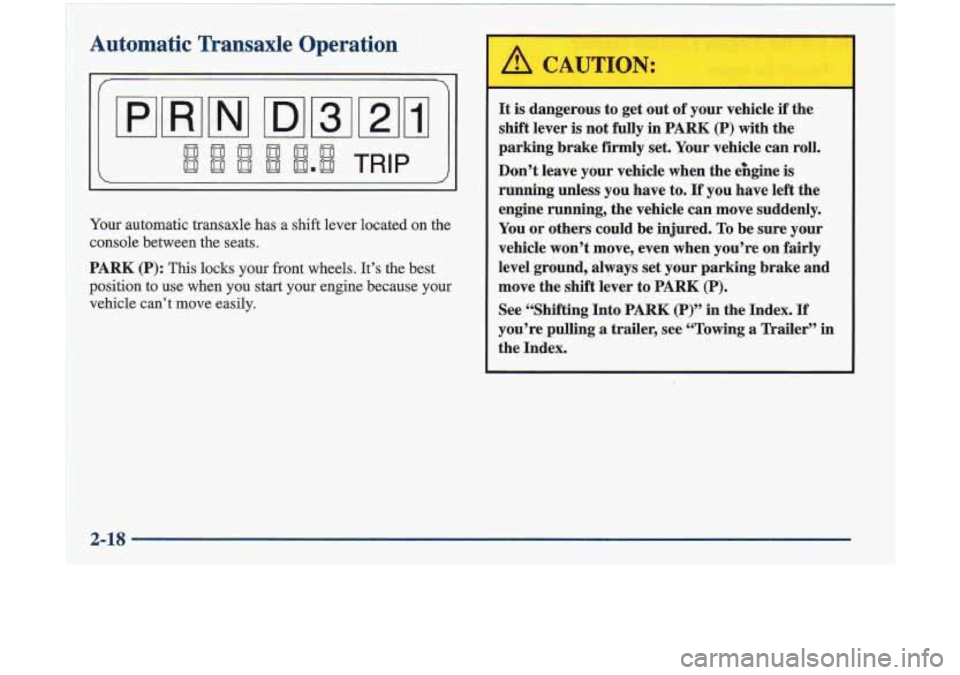
Automatic ’hansaxle Operation
k Tour automatic transaxle has a shift lever located on the
console between the seats.
PARK (P): This locks your front wheels. It’s the best
position to use when you start your engine because your
vehicle can’t move easily.
It is dangerous to get out of your vehicle if the
shift lever is not fully in PARK (P) with the
parking brake firmly set. Your vehicle can roll.
Don’t leave your vehicle when the e&&e
is
running unless you have to. If you have left the
engine running, the vehicle can move suddenly.
You or others could be injured.
To be sure your
vehicle won’t move, even when you’re
on fairly
level ground, always set your parking brake and
move the shift lever to
PARK (P).
See “Shifting Into PARK (P)” in the Index. I€
you’re pulling a trailer, see “Towing a Trailer” in
the Index.
2-18
Page 83 of 348
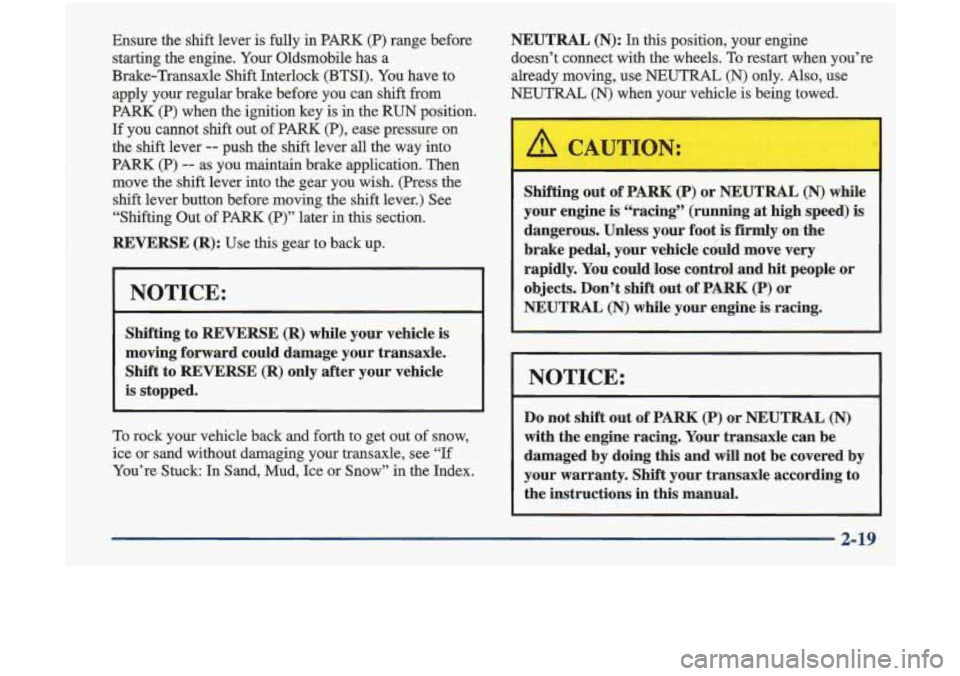
Ensure the shift lever is fully in PARK (P) range before
starting the engine. Your Oldsmobile has a
Brake-Transaxle Shift Interlock (BTSI). You have to
apply your regular brake before you can shift from
PARK
(P) when the ignition key is in the RUN position.
If you cannot shift out of PARK (P), ease pressure on
the
shift lever -- push the shift lever all the way into
PARK (P)
-- as you maintain brake application. Then
move the shift lever into the gear you wish. (Press the
shift lever button before moving the shift lever.) See
“Shifting Out of PARK
(P)” later in this section.
REVERSE (R): Use this gear to back up.
NOTICE:
Shifting to REVERSE (R) while your vehicle is
moving forward could damage your transaxle.
Shift to
REVERSE (R) only after your vehicle
is stopped.
To rock your vehicle back and forth to get out of snow,
ice or sand without damaging your transaxle,
see “If
You’re Stuck: In Sand, Mud, Ice or Snow” in the Index.
NEUTRAL (N): In this position, your engine
doesn’t connect with the wheels.
To restart when you’re
already moving, use
NEUTRAL (N) only. Also, use
NEUTRAL (N) when your vehicle is being towed.
Shifting out of PARK (P) or NEUTRAL (N) while
your engine is “racings’ (running
at high speed) is
dangerous. Unless your foot is firmly on the
brake pedal; your vehicle cdd move very
rapidly. You could lose control and hit people or
objects. Don’t shift out
of PARK (P) or
NEUTRAL
(N) while your engine is racing.
NOTICE: I
Do not shift out of PARK (P) or NEUTRAL (N)
with the engine racing. Your transaxle can be
damaged
by doing this and will not be covered by
your warranty. Shift your transaxle according to
the instructions in this manual.
2-19
Page 88 of 348
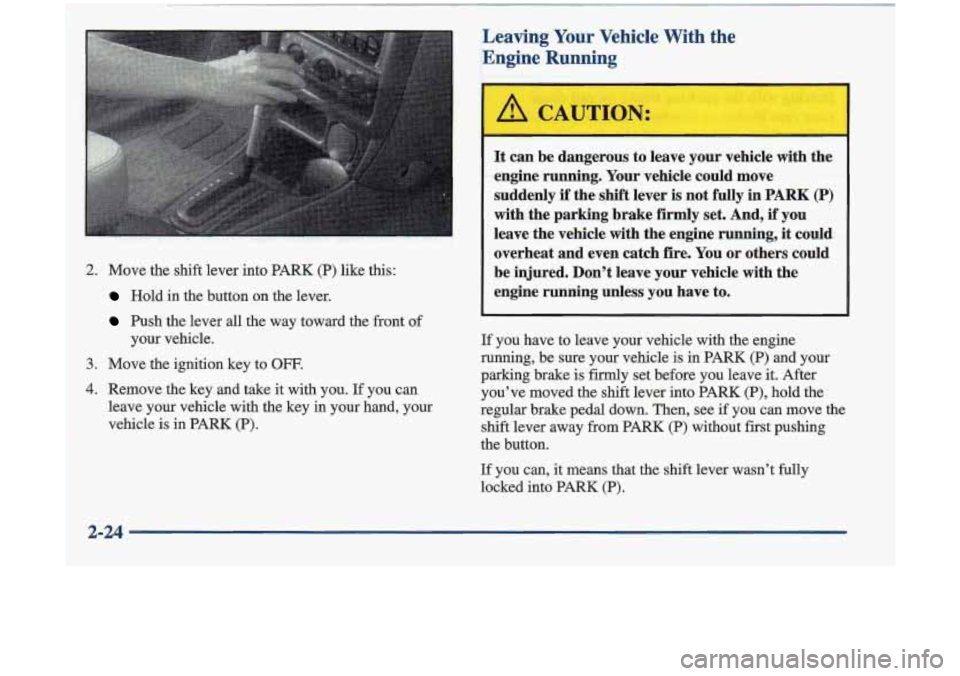
Leaving Your Vehicle With the
.;Engine Running
I
~ , . .. . - ~~~ ~ ,.-‘.“~‘,’7 ,2-- .v7.! jT.-<--. , . ~ , -
2. Move the shift lever into PARM (P) lilce this:
. . Hold jn the button on the lever.
Push the lever all the way toward the front of
your vehicle.
3. move the ignition key to OFF.
4. Remove the key and take it with you. If you can
leave your vehicle with the key in-your hand, your
veKcle
is in PARK (P).
It cm be dangerous to leave your vehicle with the
engine running. Your vehicle could move
suddenly if the shift lever
is not fully in PARK (P)
with the parking brake firmly set. And, if you
leave the vehicle
with the engine running, it could,
overheat and even catch fire. You
or others could
be.injured. Don’t leave your vehicle with the
engine
running unless you have to.
I
If you have to leave your vehicle with the engine
running, be sure your vehicle is in PARK (P) and your
parking brake is firmly set before
you leave it. After
you’ve moved the shift lever into
PARK (P), hold the
regular brake pedal down. Then, see
if you can move the
shift lever away from
PARK (P) without first pushing
the button.
If you can, it means that the shift lever wasn’t fully
locked into
PARK (p).